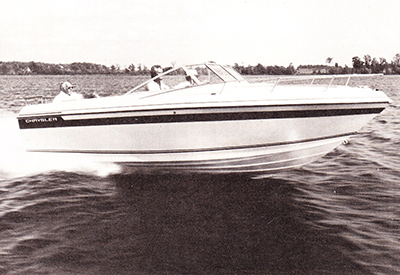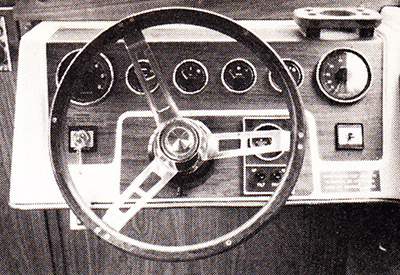Chrysler CV 223
Andy Adams
I first saw the Chrysler CV223 at an annual press convention in the summer of 1977. I liked it then and I like it even more now.
The CV223 is a big, comfortable cuddy-cabin boat sporting a deep-V hull, a head, and lots of performance. I haven’t seen many of them around and just can’t figure out why. It could be that Chrysler’s dealer organization isn’t that strong and thus the public hasn’t been turned on to the boat. Whatever the reason, people out there are missing a good trick.
Before I go further I should mention that the test boat was a press demonstrator and executive loan boat. Basically, that means it was surprising that it ran at all. We press people tend to accelerate the wear and tear a boat would normally take. The test boat had been on the rocks more than once.
Because of this ill treatment there may be some comments here that won’t apply to other CV223’s, but there is also an interesting sidelight to this that I’ll come to in the performance section.
First off, let me say that this is a good-looking boat. Several people commented favourably on the design, and the photos show more or less what I mean. The finish is close to the best I’ve seen, and nothing about the boat is second-class.
The bow is drawn to a rather sharp point and accentuated by hull graphics The effect is quite pleasing, despite
the boat’s otherwise plain lines. It is very deep and sits high in the water, yet somehow it manages to look rather racy. The long deck enhances the clever styling.
 The interior is well thought-out too. The stern jump-seats slide in and out and match up with the upholstered engine cover to make a berth. The other seats are the usual back-to-back sleepers, nicely covered and useable as two more berths. There is considerable storage under these and a portable cooler is included that fits under the passenger side.
The interior is well thought-out too. The stern jump-seats slide in and out and match up with the upholstered engine cover to make a berth. The other seats are the usual back-to-back sleepers, nicely covered and useable as two more berths. There is considerable storage under these and a portable cooler is included that fits under the passenger side.
Speaking of coolers, there are two self-draining wells in the deck over the transom for bait or sundries, both with lockable teak covers. There is an optional kitchen unit that replaces the passenger seat, but the test boat didn’t have it. However, an abundance of drink-holders and storage space, lots of sleeping accommodation and that kitchen unit would make this boat a fine day-cruiser.
Two more can be accommodated in the forward V-berth, which is long and wide enough for real comfort. It is actually better than others in much larger boats. There are side lights and a glass hatch that help make it quite liveable. A small self-contained head sits under the centre cushion and while it is not really the equal of home, one could sit with no bother, in contrast with many other boats that don’t leave sufficient headroom there.
While on the subject of comfortable accommodation, I must mention the top. While I admit it is still the traditional vinyl-over-folding-aluminum tubing, it does qualify among the best. Not only does the top stow neatly away but it goes up with little fuss, everything fits well, keeps the weather out, and if you can believe it, looks good.
The top itself has a low-slung, racy look that compliments the boat’s lines. It has good side curtains and a regular stern curtain, plus an optional camper section that was included on the test boat. It has its own set of bows and curtains, a huge picture-window stern curtain and, of all things, forward windows in the raised rear section. It lets in lots of light and frankly looks good enough to leave up. It’s a very clever outfit, gives standing headroom, and no CV223 should be without it.
 The helm-seat position is very good too. All controls are well placed, the instruments readable and all the switches lit for no-hassle night use. The wheel is slightly offset, a feature I don’t like, but it wasn’t objectionable in this case. The steering tightens up a bit despite being power assisted, but that never got as far out of hand as in some boats, even when the trim was way off.
The helm-seat position is very good too. All controls are well placed, the instruments readable and all the switches lit for no-hassle night use. The wheel is slightly offset, a feature I don’t like, but it wasn’t objectionable in this case. The steering tightens up a bit despite being power assisted, but that never got as far out of hand as in some boats, even when the trim was way off.
The instruments themselves work well enough, although the trim gauge was a bit whacko, as usual, and hard to read. Instruments are not as modern and businesslike as the latest from Mere or OMC. No complaints, but not as nice as the rest of the boat. The speedo is right on in the upper range but reads low as speed drops.
The very raked windshield didn’t throw much glare and the view is good in all directions. The long foredeck leaves no doubt that this is a big boat; while planing off it gets in the way slightly but generally the pilot has an easy time of it. Docking isn’t bad either, but the deep-V won’t swing as easily as a flatter-bottomed boat.
At speed on the water the CV223 handles well. Tight corners are no problem, the engine seldom cavitates and the whole rig has a secure feel. Rough weather won’t slow the CV223 down. The hull shape effectively smooths things out and the very stout construction ensures that few bad vibrations filter through to the captain and crew. This is a bit too big to use for skiing really, but it has the power to do it.
The engine, at 265 hp and 360 cu in., makes the CV223 a dacron is 2.2 to 16 oz. For many years the test boat had its share of abuse and the power plant is where it showed most. Cruising at 3,000 rpm gave a fuel-mileage figure of 3.29 mpg, no great but suitable to the class. Starting was another matter: something had been done to the automatic choke and it needed lots of throttle to fire up first thing in the morning. This is easily fixed.
 The gears gave some problems. Chrysler has the smoothest shift in the business, with imperceptible gear changes. I relate the rest of this to you with tongue in cheek because I could trace the problem to several areas. Who was really at fault is anybody’s guess.
The gears gave some problems. Chrysler has the smoothest shift in the business, with imperceptible gear changes. I relate the rest of this to you with tongue in cheek because I could trace the problem to several areas. Who was really at fault is anybody’s guess.
Occasionally the gears didn’t take up when the lever was moved. The shift cannot be detected anyway so you are never sure you have a gear until you advance the throttle and start to move. A couple of times the gears didn’t make the shift and the result was to rev it in neutral. Twice the gears suddenly engaged and the shock to the boat and driver was not good.
One possible cause would be the battery, which was not in good shape and may not have been providing the current to make things work. The control unit was made by Morse and seemed okay but could have been at fault too. Lastly, the gear change itself had likely been slammed from reverse to forward to reverse repeatedly in demonstration, as this is a favourite Chrysler sales trick.
Whatever the problem was, it spoiled a great engine. The 360 runs as if it’s bigger and more powerful than it really is. When I first got the boat and ran the performance test, it showed some pretty impressive numbers for such a big boat. Those figures are in the data panel. However, I think the boat liked the way I used it because it seemed to run better every time out.
The completion of the test was a short cruise with seven people aboard and someone was fooling with the radar. Just for fun I got it out, opened her up and got close to 45 with that load. Then, as I was returning, running one-up and with the camper-top up, I actually had the radar show 50 for a short burst at 5,000 rpm. Incredible for this sort of rig.
Originally published in Canadian Yachting’s March 1979 issue.
Specifications:
Length: 22ft 2.5 in.
Beam: 96 inches
Weight: 4300 lbs
Engine: Chrysler 360-cu-in. 265hp.
Photo Captions
Photo 1 – The CV223 is a big, comfortable curdy-cabin boat sporting a deep-V hull, a head, and lots of performance.
Photo 2 – top up.
Photo 3 – Running.
Photo 4 – The helm controls are well placed.






















